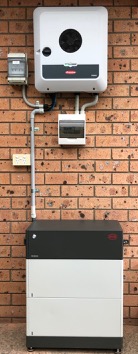Battery Storage and hybrid systems

Bunya Solar can add battery storage to any exisiting grid connected solar power system.
A battery storage system should offer the following features;
Charge batteries from excess solar power during the day.
Use the stored battery energy when the user requires it in a way that is beneficial to the user.
Be able to feed excess solar energy back into the grid once the battery is fully charged and the household power requirements are met.
Charge batteries from the grid depending on factors such as current cost of electricity.
If the batteries become depleted the system should seamlessly switch back to mains power. Battery charging should then be started again when the sun comes up or when a suitable low cost tariff is available.
Types of storage systems
The main difference between storage systems on the market today is whether or not they can provide usable backup power if the grid goes down.
The cheaper type transfers your unused solar power from the daytime to the night time for you to use in the house. However if you loose mains power (a black out) this system will not provide backup power from the battery.
The more expensive system does the same transfer of excess solar power but will also provide a limited backup power supply to your house in the event of a mains failure.
If you want the backup power option you’ll also need to ask if the system can charge its batteries from solar during a blackout, ie - if you have an extended mains failure over a few days will the batteries recharge each day from the solar or will you only get to use the power that was stored in the batteries when the power went off and then loose backup power once the batteries are discharged.
This feature of solar battery charging may not be important if you have confidence in your mains power supply. If however you live in an area where the mains power is prone to failure then it might be worth making sure that any storage system that you’re considering has this capability.
Any quote should specify overall battery life as well as the kWhrs of available power to a specified DOD. (Depth of Discharge)
Better batteries cost more but usually have an extended life compared to a cheap set.
Smart battery inverter
This could be the heart of a hybrid system. Control of the whole installation could be overseen by this inverter.
It should be able to charge the batteries from either the mains or solar and you should be able to choose which.
It will have a power rating that will tell you what it can run in the house from your battery bank before it needs help from the mains. If the mains has failed you will only be able to power loads in the house up to this power rating. For instance if the mains fails a 3kW inverter will run a 2.4kW kettle but it will turn off to protect itself if you plug in two 2.4kW kettles at once.
If the mains power is present then there wont be a problem as the inverter will provide 3kW from the batteries and source the missing 1kW from the mains.
This concept may be realised by using a battery inverter such as the Selectronic SP Pro, SMA Sunny Island or an SMA Sunny Boy Storage 5.0.
Also recently on the market is a new inverter from Fronius - the GEN24 Plus, pictured above. This is a solar and battery inverter in one unit. Comes in single and three phase versions. With no battery installed it will act like a normal solar inverter and will even supply a single power point with backup power when the mains fails (so long as the sun is shining). Adding a battery gives the system a lot of extra features. Transfer of unused excess solar power from the day time to night time. Automatic back power to selected circuits in your house during mains failure. Solar recharge each day even if the mains stays off for extended periods.
These are just a few examples of what’s available on the market.
